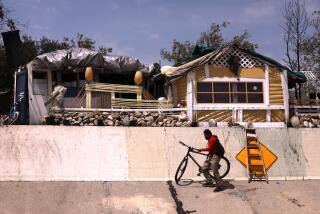Editorial: One year ago, Mayor Garcetti proposed building emergency homeless shelters. We’re still waiting
- Share via
Finding permanent housing for more than 30,000 homeless people in Los Angeles is going to be even more time-consuming and expensive than anyone expected. Even as the city gears up to spend the $1.2 billion raised under 2016’s Proposition HHH, homeless encampments are proliferating.
So it made sense that Mayor Eric Garcetti launched, a year ago, a plan that would serve as an interim solution. Under the program known as A Bridge Home, each City Council district would erect one bridge shelter, if not more, to offer several months of housing, storage and intensive support services to 100 homeless people at a time while caseworkers sought to place them in permanent housing. In exchange for accepting a bridge shelter in its midst, a neighborhood would receive intensified city cleaning services and stricter enforcement of city ordinances against homeless people camping on sidewalks during the day.
In his State of the City speech last year, Garcetti said he would budget $20 million from the city’s general fund to give communities a chance to “open beds for our homeless neighbors this year.” Homeless Angelenos, he said, “can’t wait years to get off our streets. We need more options for bringing them inside now.”
But the Bridge Home program has yet to fulfill the mayor’s vision of bringing people inside now.
A year after his speech, only two shelters have opened under the auspices of A Bridge Home. The first, El Puente, is in the historic El Pueblo district downtown near the shops and restaurants of Olvera Street. The second, in Hollywood, just opened last month. A third, at the YWCA in Hollywood, operates like a bridge shelter but is not part of the official Bridge Home program. Instead of costing a little over a million dollars per shelter, each of these facilities is coming in at roughly $3 million or more. (The city is now using state funds to help pay for the shelters.) Some proposed projects have encountered problems building on the land that had been allocated; others faced ferocious NIMBYism from neighborhoods. Nearly a year ago, City Council President Herb Wesson was engulfed in a firestorm of protest from the community over a site he picked. After meetings with community leaders, he picked another. It should be open by Labor Day. (And it will cost $5.5 million.)
The Bridge Home program has yet to fulfill the mayor’s vision of bringing people inside now.
A proposed 154-bed shelter on an empty MTA bus yard in Venice would provide much-needed beds to the large homeless population in that community. The mayor has publicly supported it. But opponents have sued the city to stop the project.
Only six bridge shelters are currently in construction. Another six have construction funds allocated and are close to breaking ground.
Nothing is easy when it comes to creating housing — even temporary housing — for homeless people in Los Angeles. And these bridge shelters are not merely trailers like the ones FEMA slaps up after a catastrophic earthquake. But still, this interim housing project is taking so long that it’s become a mini-version of the lengthy, costly effort to build permanent supportive housing.
Enter the Fray: First takes on the news of the minute »
So is this an emergency housing program or not? If it is, obviously, it needs to go faster.
Last April, Garcetti declared a shelter crisis and issued an executive directive the following month ordering all his departments to streamline applications, reviews, procurement, inspection and other things. There is still an environmental review, and it’s allowed to take up to six weeks.
By far, the lengthiest part of the process is finding a city-owned site or something a private developer will lease out. Councilman David Ryu’s office spent a year looking, first finding an underutilized Army Reserve site — which the Army refused to make available — and then finding a site on Riverside Drive. Some council members have not found any sites at all.
Some council members have simply dragged their heels. A spokesperson for Councilwoman Nury Martinez said they found a site in an industrial area in her district last September — but were unsure when it would get funded. They are only starting community outreach next month. That’s unacceptably slow. Meanwhile, interim Councilman Greig Smith has totally punted — his spokesperson says he will leave the decision on a site to the next council member, who is expected to be seated in August.
The mayor needs to pressure reluctant, slow-moving council members, and he needs to help locate sites. Once a site has been found, he needs to ride herd on the process. To his credit, Garcetti has gone to community meetings and faced resistance, telling residents that the only way to get homeless people off streets is to get them in housing. Now, he needs to redouble his efforts to get these bridge shelters sited and constructed quickly. Because this is, indeed, an emergency.
Follow the Opinion section on Twitter @latimesopinion or Facebook
More to Read
A cure for the common opinion
Get thought-provoking perspectives with our weekly newsletter.
You may occasionally receive promotional content from the Los Angeles Times.










